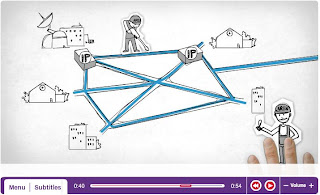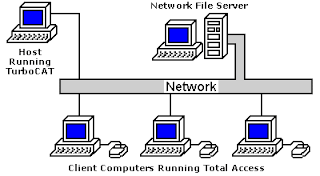Connectivity
Starting with
the obvious, a network must provide connectivity among a set of computers. Sometimes
it is enough to build a limited network that connects only a few select
machines. In fact, for reasons of privacy and security, many private
(corporate) networks have the explicit goal of limiting the set of machines
that are connected. In contrast, other networks (of which the Internet is the
prime example) are designed to grow in a way that allows them the potential to
connect all the computers in the world. A system that is designed to support
growth to an arbitrarily large size is said to scale.
Using the Internet as a model, this book addresses the challenge of
scalability.
Links, Nodes, and Clouds
Network
connectivity occurs at many different levels. At the lowest level, a network can
consist of two or more computers directly connected by some physical medium, such
as a coaxial cable or an optical fiber. We call such a physical medium a link,
and we often refer to the computers it connects as nodes.
(Sometimes a node is a more specialized piece of hardware rather than a
computer, but we overlook that distinction for the purposes of this discussion.)
As illustrated in Figure , physical links are sometimes limited to a pair of
nodes (such a link is said to be point-to-point),
while in other cases, more than two nodes may share a single physical link
(such a link is said to be multiple access).
Whether a given link supports point-to-point or multipleaccess connectivity
depends on how the node is attached to the link. It is also the case that
multiple-access links are often limited in size, in terms of both the
geographical distance they can cover and the number of nodes they can connect.
The exception is a satellite link, which can cover a wide geographic area.
 |
| Point to Point |
 |
| Multiple Access |
If computer
networks were limited to situations in which all nodes are directly connected
to each other over a common physical medium, then either networks would be very
limited in the number of computers they could connect, or the number of wires coming
out of the back of each node would quickly become both unmanageable and very
expensive. Fortunately, connectivity between two nodes does not necessarily
imply a direct physical connection between them—indirect connectivity may be
achieved among a set of cooperating nodes. Consider the following two examples
of how a collection of computers can be indirectly connected.
 |
| Switched Network |
Figure Switched Network shows a set of nodes, each of which is attached to one or more pointto- point
links. Those nodes that are attached to at least two links run software that
forwards data received on one link out on another. If organized in a systematic
way, these forwarding nodes form a switched network.
There are numerous types of switched networks, of which the two most common are
circuit switched and packet
switched. The former is most notably employed by the
telephone system, while the latter is used for
the overwhelming
majority of computer networks and will be the focus of this blog.
The important
feature of packet-switched networks is that the nodes in such a network send
discrete blocks of data to each other. Think of these blocks of data as
corresponding to some piece of application data such as a file, a piece of
email, or an image. We call each block of data either a packet
or a message, and for now
we use these terms interchangeably; we discuss the reason they are not always
the same in next article. Packet-switched networks typically use a strategy
called store-and-forward.
As the name suggests, each node in a store-and-forward network first receives a
complete packet over some link, stores the packet in its internal memory, and
then forwards the complete packet to the next node. In contrast, a
circuit-switched network first establishes a dedicated circuit across a
sequence of links and then allows the source node to send a stream of bits
across this circuit to a destination node. The major reason for using packet
switching rather than circuit switching in a computer network is efficiency,
discussed in the next subsection.
The cloud in
Figure 1.3 distinguishes between the nodes on the inside that implement
the network (they are commonly called switches,
and their sole function is to store and forward packets) and the
nodes on the outside of the cloud that use the
network (they are commonly called hosts, and
they support users and run application programs). Also note that the cloud in
Figure 1.3 is one of the most important icons of computer networking. In
general, we use a cloud to denote any type of network, whether it is a single
point-to-point link, a multiple-access link, or a switched network. Thus,
whenever you see a cloud used in a
figure, you can think of it as a placeholder for any of the networking technologies
covered in this blog.
No comments:
Post a Comment